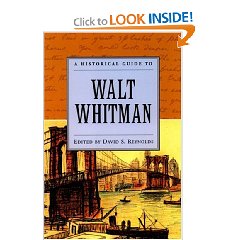A Historical Guide to Walt Whitman
edited by David S. Reynolds (click on the image to go to the Amazon.com shop)
This book is part of a series “Historical Guides to American Authors” and starts with an introduction by the editor David S. Reynolds. He also contributes with a short biography of the poet.
This is followed by scholarly essays by well knows Whitmaniacs including Ed Folsom, which an average Whitman lover definitely did come across. In his essay he deals with Whitman’s stance on racism. Moreover, he specifically pinpoints places in Whitman’s poetry where he mentions or uses a metaphor to refer to black people. He focuses on poems “The Sleepers” and “Ethiopia Saluting the Colors” in his essay.
In the next essay, Jerome Loving writes about the Leaves as political poems which is definitely interesting to read because people not so often discuss these poems as political. Whitman was a great democrat and a patriot, and for someone who wants to deal with these topics, this is a must read. I would advise this part to be read together with the last essay “Whitman the Democrat” because both deal with similar but in many ways different notions. Politics and human rights are closely linked. One of the basic human rights is a right to express love. Killingsworth’s essay “Whitman and the Gay American Ethos” , as the title says looks at Whitman as a gay poet. The author finds examples of this in I Sing the Body Electric, Calamus clusters.
Roberta Tarbell speaks of links between the visual arts and Whitman. A large portion of the essay deals with architecture and technological advances in architecture which I did not find very interesting. On the other side of the medallion, the parts of the essays describing Whitman and love of photography and painting were really insightful. Worth a look. Tarbell finishes with Whitman’s influence on the coming artists.
One of the most useful thins I found in this book is definitely the illustrated chronology of Whitman’s life and career.


Josip,
Thanks for this recommendation, which for some reason I realize I never made to my own class, though we discussed many of its topics. I know you submitted answers for my student Meghan who is researching Whitman’s current reception (thank you for doing that!! She will be very grateful) and one thing that interests her is whether readers turn to Leaves for its beauty (poetry) or its philosophy/politics– or both? Studies suggest that many early readers, led by American socialists who admired Whitman (including his interviewer Traubel), really saw him more as a philosopher, and studied his works to extract his vision of democracy, equality, the sacredness of all humanity, etc. Some poets in the modernist period were grappling with his poetic voice, long lines and free verse, etc., but many readers almost seemed to overlook the genre of his work. Much of this was born out in the recent survey I did of English-language journals from early in the 20th century:
http://mscanlon.lookingforwhitman.org/2009/11/17/a-whitman-sampler-in-the-age-of-modernism/
Thanks again for all your interesting work!